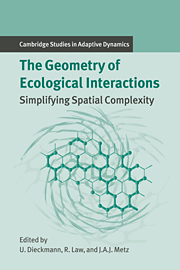Book contents
- Frontmatter
- Contents
- Contributing Authors
- 1 Introduction
- Part A Empirical and Statistical Background: A Plant Ecological Perspective
- Part B When the Mean-field Approximation Breaks Down
- Introduction to Part B
- 6 Grid-based Models as Tools for Ecological Research
- 7 Coexistence of Replicators in Prebiotic Evolution
- 8 Games on Grids
- 9 The Interplay between Reaction and Diffusion
- 10 Spirals and Spots: Novel Evolutionary Phenomena through Spatial Self-structuring
- 11 The Role of Space in Reducing Predator–Prey Cycles
- Part C Simplifying Spatial Complexity: Examples
- Part D Simplifying Spatial Complexity: Techniques
- References
- Index
- International Institute for Applied Systems Analysis
6 - Grid-based Models as Tools for Ecological Research
Published online by Cambridge University Press: 14 January 2010
- Frontmatter
- Contents
- Contributing Authors
- 1 Introduction
- Part A Empirical and Statistical Background: A Plant Ecological Perspective
- Part B When the Mean-field Approximation Breaks Down
- Introduction to Part B
- 6 Grid-based Models as Tools for Ecological Research
- 7 Coexistence of Replicators in Prebiotic Evolution
- 8 Games on Grids
- 9 The Interplay between Reaction and Diffusion
- 10 Spirals and Spots: Novel Evolutionary Phenomena through Spatial Self-structuring
- 11 The Role of Space in Reducing Predator–Prey Cycles
- Part C Simplifying Spatial Complexity: Examples
- Part D Simplifying Spatial Complexity: Techniques
- References
- Index
- International Institute for Applied Systems Analysis
Summary
Introduction
Ecosystems typically are spatially heterogeneous. Most textbooks on ecology state that spatial structures play an essential role in the dynamics and functioning of ecosystems, for example, in their biodiversity. However, only a limited number of ecological field studies have investigated the spatial distribution of ecological elements (e.g., individuals of different species) and the ways this distribution changes over time. Ecological data are often collected over short time periods (3–5 years) at a few representative locations. But the questions of interest to ecologists often relate to longer time scales and larger areas. Ecological models can help to answer these questions by processing these short-term, small-scale data and deducing their consequences for longer periods of time and for larger areas.
Usually, however, not all the information needed for a model is available from hard data. Weak data, estimations, and plausible assumptions have to be added to achieve a closed problem. To keep the model realistic, it should be founded on good ecological knowledge and data and not be based solely on assumptions. For this reason, close collaboration between the modeler and field ecologists is necessary if the models are to produce ecologically relevant results.
At this point, it is necessary to remember that a multitude of possible objectives can be addressed by models. Models can be divided into two categories: those that aim at general understanding of ecological processes, and those that aim at predicting future events. Classic ecological models that use mathematical equations, especially differential equations, primarily belong to the first category. Much of their structure is driven by the need to keep the mathematics feasible. For this reason, they are seldom suitable for dealing with specific ecological situations.
Information
- Type
- Chapter
- Information
- The Geometry of Ecological InteractionsSimplifying Spatial Complexity, pp. 94 - 115Publisher: Cambridge University PressPrint publication year: 2000
Accessibility standard: Unknown
Why this information is here
This section outlines the accessibility features of this content - including support for screen readers, full keyboard navigation and high-contrast display options. This may not be relevant for you.Accessibility Information
- 8
- Cited by
